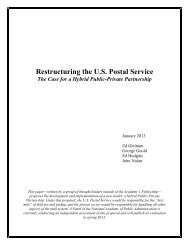High-Performance Partnerships - National Academy of Public ...
High-Performance Partnerships - National Academy of Public ...
High-Performance Partnerships - National Academy of Public ...
Create successful ePaper yourself
Turn your PDF publications into a flip-book with our unique Google optimized e-Paper software.
TABLE 2-1<br />
SECTOR DIFFERENCES<br />
<strong>Public</strong> Nonpr<strong>of</strong>it Business<br />
Prime Motivation <strong>Public</strong> good Mission Pr<strong>of</strong>it<br />
Prime Decision-Makers Elected Officials Board <strong>of</strong> Owners/CEO<br />
Directors/CEO<br />
Accountable to <strong>Public</strong> Donors Owners<br />
Funding source Taxpayers Donors/contractors Customers<br />
Degree <strong>of</strong> public influence Great Moderate Limited<br />
whom they are accountable, and who makes<br />
decisions. These distinctions are summarized<br />
in Table 2-1.<br />
The sectors <strong>of</strong>fer different strengths to a partnership.<br />
Nonpr<strong>of</strong>its contribute their mission orientation,<br />
expertise, and community trust. The<br />
business sector <strong>of</strong>fers resources and entrepreneurial<br />
expertise. The public sector contributes<br />
significant resources, as well as its sense <strong>of</strong> the<br />
“community good.” Not every organization will<br />
exactly fit this stereotype, but these observations<br />
are generally consistent with sector leader<br />
polling across the country (Pew).<br />
Numerous forces cause the sectors’ traditional<br />
distinctions to blur. 1 Some nonpr<strong>of</strong>its and<br />
businesses provide services once exclusively<br />
associated with the public sector, such as jails,<br />
public transportation, and welfare. The public<br />
and nonpr<strong>of</strong>it sectors are becoming more businesslike<br />
in their focus on customer service,<br />
operation efficiency, and bottom line results.<br />
<strong>High</strong>lighted below are some <strong>of</strong> the economic<br />
and social pressures that are encouraging sectors<br />
to perform better and work together.<br />
TRENDS SUPPORTING<br />
PERFORMANCE-BASED<br />
PARTNERSHIPS<br />
Numerous trends are forcing the public, business,<br />
and nonpr<strong>of</strong>it sectors to continually<br />
assess how they do business. These trends<br />
include devolution, performance-based<br />
reform, collaboration, and customer expectations<br />
in the Internet age.<br />
DEVOLUTION: DOING<br />
MORE WITH LESS 2<br />
Devolution decentralizes historically federal<br />
responsibilities to lower levels <strong>of</strong> government.<br />
Funding may or may not accompany this shift.<br />
Begun primarily in the 1980s, devolution was<br />
premised on the belief that state and local governments<br />
can deliver social services more<br />
effectively if they were given the responsibility<br />
and flexibility to do so.<br />
In 1981, the federal government consolidated<br />
57 categorical grant programs into nine larger,<br />
more flexible block grants. Decreased federal<br />
spending accompanied the block grants so<br />
they arrived at the states with less money.<br />
Those most effected were Medicaid, food<br />
stamps, welfare, employment, and job training<br />
recipients, as were children in school lunch<br />
and disability programs. Devolution continued<br />
into the next decade as welfare reform legislation,<br />
specifically the Personal Responsibility<br />
and Work Opportunity Act <strong>of</strong> 1996, gave flexibility<br />
to states to design their own implementation<br />
plans. At the same time, the law set new<br />
limits on how long families could receive food<br />
stamps and welfare payments. In addition, the<br />
nation’s commitment to the arts was tied to<br />
devolution; Congress required that 40 percent<br />
<strong>of</strong> federal appropriations for the arts be directed<br />
to state arts agencies (Coble 1999).<br />
1. The Three Sector Initiative, sponsored by national public, private, and nonpr<strong>of</strong>it sector organizations, has produced an especially insightful report<br />
that discusses these and other trends in greater detail (Fosler).<br />
2. Major portions <strong>of</strong> this section are reprinted from <strong>Public</strong>/Nonpr<strong>of</strong>it Sector <strong>High</strong>-performance <strong>Partnerships</strong>: Resource Guide. <strong>National</strong> <strong>Academy</strong> <strong>of</strong><br />
<strong>Public</strong> Administration, 2001.<br />
25 Powering the Future: <strong>High</strong>-<strong>Performance</strong> <strong>Partnerships</strong>









